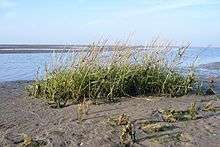Spartina anglica
Spartina anglica (common cordgrass[1]) is a species of cordgrass that originated in southern England in about 1870 and is a neonative species endemic to Britain.[2] It was reclassified as Sporobolus anglicus after a taxonomic revision in 2014,[3] but Spartina anglica is still in common usage.[4]:1119 It is an allotetraploid species derived from the hybrid Spartina × townsendii, which arose when the European native cordgrass Spartina maritima (Small Cordgrass) hybridised with the introduced American Spartina alterniflora (Smooth Cordgrass).[2][4]
| Spartina anglica | |
|---|---|
 | |
| Scientific classification | |
| Kingdom: | |
| (unranked): | |
| (unranked): | |
| (unranked): | |
| Order: | |
| Family: | |
| Genus: | |
| Species: | S. anglica |
| Binomial name | |
| Spartina anglica | |
It is a herbaceous perennial plant growing 0.4-1.3 m tall, yellowish green in spring and summer, and turning light brown in autumn and winter. The leaves are 20–60 cm long, and 1.5 cm broad at the base, tapering to a point. It produces flowers and seeds on only one side of the stalk. The flowers are a yellowish-green, turning brown by the winter.
Invasive problems
Spartina anglica was at first seen as a valuable new species for coastal erosion control, its dense root systems binding coastal mud and the stems increasing silt deposition, thereby assisting in land reclamation from the sea. As a result, it was widely planted at coastal sites throughout the British Isles, and has colonised large areas of tidal mudflats, becoming an invasive species. New colonies may take some time to become established, but once they do, vegetative spread by rhizomes is rapid, smothering natural ecosystems and preventing birds like waders from feeding. In some areas however, a natural dieback of unknown cause has reversed the spread, and artificial control is no longer necessary where this dieback has occurred.
It has also been introduced to Asia, Australia, New Zealand and North America, where it has proved to be a serious invasive species causing extensive damage to natural saltmarsh ecosystems in all areas.
Further reading
Smiddy, P. 2020.The status and distribution of Common Cord-grass (Spartina anglica) at Dungarvan, Co. Waterford, and an evaluation of ecological effects. Irish Naturalists' Journal. 37:9 - 13.
References
- "BSBI List 2007". Botanical Society of Britain and Ireland. Archived from the original (xls) on 2014-10-23. Retrieved 2014-10-17.
- Cope, Tom; Gray, Alan (2009). Grasses of the British Isles: BSBI Handbook No.13. Botanical Society of Britain and Ireland. ISBN 978-0-901158-420.
- Peterson, PM , et al (2014) A molecular phylogeny and new subgeneric classification of Sporobolus (Poaceae: Chloridoideae: Sporobolinae), Taxon 63: 1212-1243.
- Stace, Clive (2019). New Flora of the British Isles (4 ed.). C & M Floristics. ISBN 978-1-5272-2630-2.
External links
- UK Joint Nature Conservation Committee: Spartina anglica
- English Nature: Spartina summary
- San Francisco Estuary Invasive Spartina Project
| Wikimedia Commons has media related to Spartina anglica. |